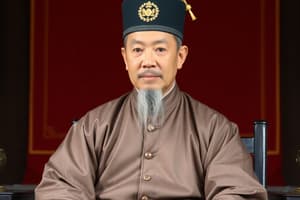Podcast
Questions and Answers
Nguyễn Dynasty는 1802년에 설립됐으며, Gia Long이越南을 통일시켰습니다.
Nguyễn Dynasty는 1802년에 설립됐으며, Gia Long이越南을 통일시켰습니다.
True (A)
Minh Mạng은 1840년에 사망했습니다.
Minh Mạng은 1840년에 사망했습니다.
True (A)
프랑스는 1862년에 越南을 실질적으로 식민지로 삼았습니다.
프랑스는 1862년에 越南을 실질적으로 식민지로 삼았습니다.
True (A)
Trịnh-Nguyễn 전쟁은 1673년에 끝났습니다.
Trịnh-Nguyễn 전쟁은 1673년에 끝났습니다.
Tây Sơn 반란은 1802년에 끝났다.
Tây Sơn 반란은 1802년에 끝났다.
MANDARINS는 Nguyễn Dynasty의 행정에서 핵심적인 역할을 하였습니다.
MANDARINS는 Nguyễn Dynasty의 행정에서 핵심적인 역할을 하였습니다.
Nguyễn Dynasty는 越南의 현대적 정체성을 형성하는데 중요한 역할을 했습니다.
Nguyễn Dynasty는 越南의 현대적 정체성을 형성하는데 중요한 역할을 했습니다.
Bảo Đại는 1945년에abdicated하지 않았다.
Bảo Đại는 1945년에abdicated하지 않았다.
Flashcards are hidden until you start studying
Study Notes
Nguyễn Dynasty (1802-1945)
Founding and Early Years
- Founded by Gia Long (1802-1820), who unified Vietnam after centuries of division
- Capital established in Huế
- Nguyễn Dynasty was the last royal dynasty in Vietnam
Reign of Minh Mạng (1820-1840)
- Implemented Confucianism as the official ideology
- Strengthened the monarchy and bureaucracy
- Expanded Vietnam's borders through military campaigns
- Isolated Vietnam from European influence
French Colonization (1862-1945)
- France colonized Vietnam, ending the Nguyễn Dynasty's independence
- Nguyễn kings became figureheads under French rule
- Last king, Bảo Đại, abdicated in 1945, marking the end of the dynasty
Notable Events and Figures
- Trịnh-Nguyễn War (1627-1673): conflict between the Trịnh and Nguyễn lords
- Tây Sơn Rebellion (1771-1802): peasant uprising that led to the fall of the Nguyễn lords and the rise of Gia Long
- mandarins: high-ranking officials who played a crucial role in the Nguyễn Dynasty's administration
Legacy
- The Nguyễn Dynasty played a significant role in shaping Vietnam's modern identity
- Huế, the former capital, remains a cultural and historical hub in Vietnam
- The dynasty's legacy continues to influence Vietnamese politics, culture, and society
응우옌 왕조 (1802-1945)
창립 및 초기 연대
- 1802년 기라롱(Gia Long)에 의해 베트남 통일
- 후에(Huế)제도 설치
- 베트남最後의 왕조
민망( Minh Mạng) 통치 (1820-1840)
- 공산주의를 공식 이데올로지로 채택
- 군주제와 관료제 강화
- 군사 작전을 통해 베트남 국경 확장
- 유럽의 영향에 대한 고립
프랑스 식민지 (1862-1945)
- 프랑스에 의해 베트남 식민지화, 응우옌 왕조의 독립 종식
- 응우옌 왕들이 프랑스 지배하에 형식상의 지위에 있게 됨
- 마지막 왕 보대(Bảo Đại)는 1945년에 항복, 왕조의 종결을 맞이
주요 사건 및 인물
- 쯔르-응웬 전쟁 (1627-1673) : 쯔르와 응웬의 영주 간의 분쟁
- 서산의 반란 (1771-1802) : 농민 봉기, 응웬 영주의 몰락과 기라롱의 역할
- 중신 : 응우옌 왕조 행정부의 중추적 역할을 수행한 고위 관료
유산
- 응우옌 왕조는 베트남의 현대 정체성 형성에 중요한 역할을 했다
- 후에(Huế)는 베트남의 문화 및 역사적 중심지로 남아
- 왕조의 유산은 베트남의 정치, 문화, 사회에 계속 영향을 미치고 있다
Studying That Suits You
Use AI to generate personalized quizzes and flashcards to suit your learning preferences.




